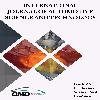Evaluation of the effect of the novolac resin ratio on the high temperature performance of the brake pads
Evaluation of the effect of the novolac resin ratio on the high temperature performance of the brake pads
The resin is a widely used binder in the brake pads. Determining the optimum, resin ratio is important for the brake pad to show the best wear and braking performance. In this article, the impression of the novolac resin ratio (15% and 30%) on the perfor-mance of the brake pads at high temperatures was studied. Friction experiments of the brake pads were performed according to ASTM G99–95a test standard in Pin-on disc test device at 350 °C. The average friction coefficients obtained in the friction tests of 15% and 30% novolac resin samples at 500 rpm rotation speed, 350 C temperature, and 10 N load were 0.151 and 0.308, respectively. With the increase in the novolac res-in ratio, the hardness, density, and thermal conductivity of the brake pads have in-creased.
Keywords:
Brake Pad, Novolac Resin;, High Temperature Friction Coefficient,
___
- [1] Y.C. Kim, M.H. Cho, S.J. Kim, H. Jang, The effect of phenolic resin, potassium titanate, and CNSL on the tribological properties of brake friction materials, Wear, 264 (2008) 204-210.
- [2] G. Akıncıoğlu, S. Akıncıoğlu, H. Öktem, İ. Uygur, Wear response of non-asbestos brake pad composites reinforced with walnut shell dust, Journal of the Australian Ceramic Society, 56 (2020) 1061-1072.
- [3] H. Öktem, S. Akıncıoğlu, İ. Uygur, G. Akıncıoğlu, A novel study of hybrid brake pad composites: new formulation, tribological behaviour and characterisation of microstructure, Plastics, Rubber and Composites, (2021) 1-13.
- [4] S. Koch, E. Köppen, N. Gräbner, U. von Wagner, On the influence of multiple equilibrium positions on brake noise, Facta Universitatis, Series: Mechanical Engineering, (2021).
- [5] G. Akıncıoğlu, İ. Uygur, H. Öktem, S. Akıncıoğlu, Bor oksit tozunun fren balatalarının tribolojik özelliklerine etkisi, Sakarya University Journal of Science, 22 (2018) 755-760.
- [6] P. Gurunath, J. Bijwe, Friction and wear studies on brake-pad materials based on newly developed resin, Wear, 263 (2007) 1212-1219.
- [7] G. Akıncıoğlu, S. Akıncıoğlu, H. Öktem, İ. Uygur, Evaluation of the physical properties of hazelnut shell dust-added brake pad samples treated with cryogenic process, Politeknik Dergisi, 22 (2019) 591-596.
- [8] R. Ertan, N. Yavuz, An experimental study on the effects of manufacturing parameters on the tribological properties of brake lining materials, Wear, 268 (2010) 1524-1532.
- [9] C. Menapace, M. Leonardi, M. Secchi, A. Bonfanti, S. Gialanella, G. Straffelini, Thermal behavior of a phenolic resin for brake pad manufacturing, Journal of Thermal Analysis and Calorimetry, 137 (2019) 759-766.
- [10] H.Q. Wang, X.Y. Wu, T.S. Li, X.J. Liu, P.H. Cong, Effect of the matrix resin structure on the mechanical properties and braking performance of organic brake pads, Journal of applied polymer science, 126 (2012) 1746-1753.
- [11] S.J. Kim, H. Jang, Friction and wear of friction materials containing two different phenolic resins reinforced with aramid pulp, Tribology international, 33 (2000) 477-484.
- [12] M. Lagel, L. Hai, A. Pizzi, M. Basso, L. Delmotte, S. Abdalla, A. Zahed, F. Al-Marzouki, Automotive brake pads made with a bioresin matrix, Industrial Crops and Products, 85 (2016) 372-381.
- [13] Y. Wu, M. Zeng, Q. Xu, S. Hou, H. Jin, L.J.T.I. Fan, Effects of glass-to-rubber transition of thermosetting resin matrix on the friction and wear properties of friction materials, Tribology International, 54 (2012) 51-57.
- [14] J. Bijwe, N. Majumdar, B.J.W. Satapathy, Influence of modified phenolic resins on the fade and recovery behavior of friction materials, Wear, 259 (2005) 1068-1078.
- [15] J. Bijwe, M. Kumar, Optimization of steel wool contents in non-asbestos organic (NAO) friction composites for best combination of thermal conductivity and tribo-performance, Wear, 263 (2007) 1243-1248.
- [16] U. Hong, S. Jung, K. Cho, M. Cho, S. Kim, H.J.W. Jang, Wear mechanism of multiphase friction materials with different phenolic resin matrices, Wear, 266 (2009) 739-744.
- [17] B.S. Joo, Y.H. Chang, H.J. Seo, H. Jang, Effects of binder resin on tribological properties and particle emission of brake linings, Wear, 434 (2019) 202995.
- [18] M. Shin, J. Kim, B. Joo, H.J.T.L. Jang, Wear and friction-induced vibration of brake friction materials with different weight average molar mass phenolic resins, Tribology Letters, 58 (2015) 1-8.
- [19] M.H. Cho, S.J. Kim, D. Kim, H. Jang, Effects of ingredients on tribological characteristics of a brake lining: an experimental case study, Wear, 258 (2005) 1682-1687.
- [20] S. Manoharan, R. Vijay, D.L. Singaravelu, M. Kchaou, Experimental investigation on the tribo-thermal properties of brake friction materials containing various forms of graphite: a comparative study, Arabian Journal for Science and Engineering, 44 (2019) 1459-1473.
- [21] G. Akıncıoğlu, S. Akıncıoğlu, H. Öktem, İ. Uygur, Brake pad performance characteristic assessment methods, International Journal of Automotive Science and Technology, 5 67-78.
- [22] R. Yun, P. Filip, Y. Lu, Performance and evaluation of eco-friendly brake friction materials, Tribology International, 43 (2010).
- [23] G. Akıncıoğlu, H. Öktem, I. Uygur, S. Akıncıoğlu, Determination of friction-wear performance and properties of eco-friendly brake pads reinforced with hazelnut shell and boron dusts, Arabian Journal for Science and Engineering, 43 (2018) 4727-4737.
- [24] G. Akıncıoğlu, S. Akıncıoğlu, H. Öktem, İ. Uygur, Experimental investigation on the friction characteristics of hazelnut powder reinforced brake pad, Reports in Mechanical Engineering, 2 (2021) 23-30.
- [25] J. Otto, G.-P. Ostermeyer, High-frequency vibrations in the contact of brake systems, Facta Universitatis, Series: Mechanical Engineering, 17 (2019) 103-112.
- [26] P. Cai, Y. Wang, T. Wang, Q. Wang, Effect of resins on thermal, mechanical and tribological properties of friction materials, Tribology international, 87 (2015) 1-10.
- Yayın Aralığı: Yılda 4 Sayı
- Başlangıç: 2016
- Yayıncı: Otomotiv Mühendisleri Derneği
Sayıdaki Diğer Makaleler
Serdar Halis, Hamit Solmaz, Seyfi Polat, . Serdar Yücesu
Kemal Ermiş, Mehmet Çalışkan, Anıl Okan
Mehmet Celik, Cihan Bayindirli, M. İlhan İlhak
Review On Electric Vehicle Fire Hazards Associated with Batteries, Combustibles and Smoke
A discussion on design fires for high-speed railway train cars
